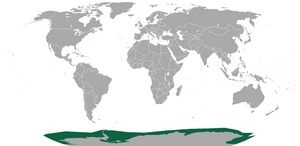Ross seal facts for kids
Quick facts for kids Ross seal |
|
|---|---|
 |
|
| Conservation status | |
| Scientific classification | |
| Genus: |
Ommatophoca
|
| Species: |
rossii
|
 |
|
| Ross seal range | |
The Ross seal (Ommatophoca rossii) is a type of true seal that lives only in the icy waters around Antarctica. It's the only species in its group, called Ommatophoca. Scientists first found it in 1841 during an expedition. It is the smallest and rarest of the seals living in Antarctica, and not much is known about it.
Ross seals have really big eyes, which is why their scientific name means "eye seal." They also make cool, trilling and siren-like sounds. These seals have short, wide snouts and the shortest fur of all seals.
Contents
Understanding Ross Seal Relatives
The Ross seal is related to three other seals that live in Antarctica. These are the crabeater seal, leopard seal, and Weddell seal. Together, they are known as the lobodontine seals. This group of seals has special teeth that help them catch small food from the water.
Scientists believe these Antarctic seals separated from their closest relatives, the elephant seals, a long time ago. This happened when they moved south and started living only around Antarctica. The oldest Ross seal fossils found so far are from New Zealand.
What Does a Ross Seal Look Like?
Ross seals usually grow to be about 1.7 to 2.1 meters (5.5 to 6.9 feet) long. They weigh between 129 and 216 kilograms (284 to 476 pounds). Female seals are a little bit bigger, reaching up to 2.5 meters (8.2 feet). When they are born, pups are about 1 meter (3.3 feet) long and weigh around 16 kilograms (35 pounds).
Their fur is dark brown on their backs and silvery-white underneath. As the Antarctic winter begins, their fur slowly fades to a lighter brown color. You can easily spot a Ross seal by its very large eyes, which can be up to 7 centimeters (2.8 inches) wide.
Unique Sounds of the Ross Seal
Ross seals can make many different complex sounds, like twitters and siren-like noises. They make these sounds both on the ice and underwater. Underwater, their calls can travel for long distances. The siren sound they make underwater can even have two different tones at the same time.
What's really special is that they make these sounds with their mouths closed, without letting out any air. Scientists don't know exactly why they make these sounds. However, because the sounds are so unique and travel far, they probably help seals find each other or avoid each other.
Where Do Ross Seals Live?
Even though their relatives like the Weddell, crabeater, and leopard seals are common in Antarctic waters, the Ross seal is rare. It is considered the least common seal living in the pack ice. Ross seals almost never leave the Antarctic Ocean. Very rarely, a stray seal might be seen near subantarctic islands or even off the coast of Australia.
However, Ross seals can be found all around Antarctica. They live alone or in small groups in the very thick pack ice.
Ross Seal Population Status
Scientists estimate there are about 130,000 Ross seals in total. But this number can vary a lot, with estimates ranging from 20,000 to 227,000. Because of this, not much is known about whether their population is growing or shrinking.
A study of their genes did not find signs that their population has recently dropped a lot. This suggests that the number of Ross seals has likely stayed steady in recent times. Humans have not interacted much with Ross seals. They have been collected by expeditions for scientific study, but their habitat generally does not overlap with commercial fishing areas.
Ross Seal Feeding and Life Cycle
Ross seals mostly eat squid and fish, especially Antarctic silverfish. They hunt for food in the open water, away from the bottom. Large predators like killer whales and leopard seals also live in Antarctica. Scientists believe these animals might hunt Ross seals, but no one has ever seen it happen.
Female Ross seals give birth to their pups on the ice in November. The pups are nursed by their mothers for only about four weeks before they stop drinking milk. Scientists think that mating happens underwater shortly after the pup is weaned, but this has never been seen. Ross seals become old enough to have their own babies at about three years of age. They are thought to live for around 20 years in the wild.
See also
 In Spanish: Foca de Ross para niños
In Spanish: Foca de Ross para niños


